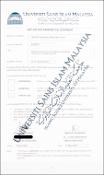Options
Window design for optimum classroom daylight in islamic school
Date Issued
2020-05
Author(s)
Raja Nur Syaheeza Raja Mohd Yazit
Abstract
Efficient daylighting improves students' performance such as writing tasks in classrooms. Daylighting adequacy in the classroom is assessed through the standardized window design, which is 20 per cent of the Window-to-Floor Ratio (WFR). The illuminance level is measured at 800mm to 900mm working plane height with the window sill at the same height, where these are the variables focused by other researches on classroom daylight. However, the Islamic religious school that prioritizes the Quran memorization (hafazan) tasks through reading and writing Arabic language uses a low reading desk (rehal) with 300mm working plane height. Due to the current practice of integrating academic and religious subjects in classrooms, religious schools follows the standardised window design and table with 800mm to 900mm working plane height, where using a rehal will influence the illuminance level measured. The objectives of this research are to identify the acceptable illuminance level for students' optimum Arabic handwriting performance, to investigate the influence of window design on illuminance level measured at working plane of 300mm height, and to recommended window sill height for students’ optimum Arabic handwriting performance for learning hafazan at the working plane of 300mm height in Islamic religious school. Classrooms with recommended 20 per cent of WFR were selected, where three experiments with different window sill height and working plane height were conducted. The field measurement method to identify the average illuminance level of the classrooms was illuminance grid points measurement, where the lux meter was placed in a 1m x 1m grid layout of the classroom. The survey on students' perceptions of the daylight condition and task performances were measured through a five level Likert scale type questionnaire, while the Arabic handwriting performance test was conducted in the classroom to measure the students’ word per minute (wpm) using modified Balsam Alabdulkader-Leat (BAL) eye chart. The results then referred as the parameters for daylight simulation in Integrated Environment Simulation (IES) software to evaluate the window sill height for classrooms that uses rehal. The range of average illuminance level measure in the classrooms was 280 lx to 1600 lx. The questionnaire results show that the students accepted the illumination at the condition of 20 per cent WFR in the classroom. The Arabic handwriting assessment shows that students scored higher wpm in a classroom that received lower average illuminance level than recommended in standards and guidelines, which was 280 lx. The simulation shows that window sill height above 500mm exceeds the 280 lx average illuminance level, while window sill height between 300mm to 500mm received average illuminance level between 223 lx to 284 lx. Thus, the acceptable window sill height recommended for religious schools is between 300mm to 500mm. This recommendation will improve the standard design of Islamic schools by architects and designers, which will improve the students’ Arabic handwriting performance for hafazan learning process.
File(s)

Loading...
Name
4160107 declaration.pdf
Size
1.15 MB
Format
Adobe PDF
Checksum
(MD5):e0650ec597ca00d76f8e7ae82bc411e7
Loading...
Name
4160107 introduction.pdf
Size
2.11 MB
Format
Adobe PDF
Checksum
(MD5):bd2c0915fbb941fbb464f5ade9200117